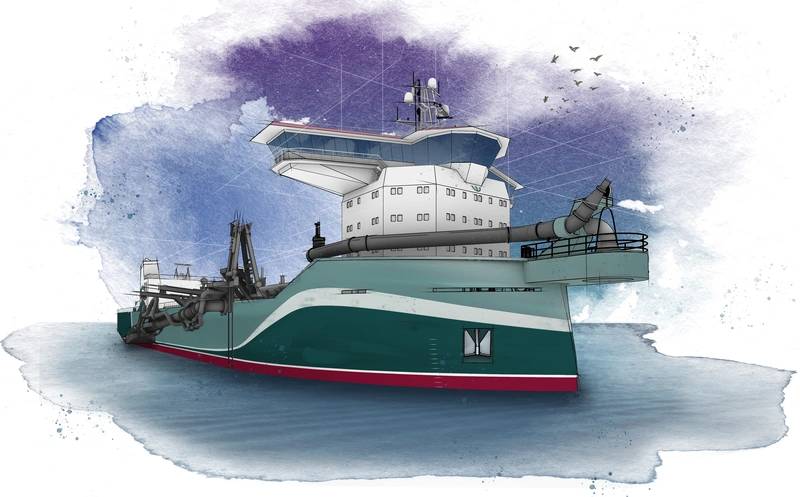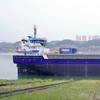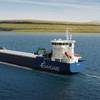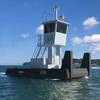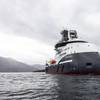VIDEO: Basjan Faber Discusses the Creation of C-Job’s Customizable TSHD Series
With an eye on an aging trailing suction hopper dredge fleet, C-Job is set to debut an innovative new THSD design series with a focus on modularity and sustainability. Basjan Faber, CEO, C-Job Naval Architects, discusses the dredging market and the new design with Maritime Reporter & Engineering News.
Without equivocation, the Dutch know dredging. The country name itself—“the Netherlands”—literally means "the lowlands" and refers to the geographic features of the land being both flat and down river from higher areas, and only about 50% of the Netherlands is more than one meter above sea level.
So when we wanted to talk modern dredge design, a natural first stop is Basjan Faber, CEO of C-Job Naval Architects based in Amsterdam, with offices globally. “Born to Design” is how we described Faber in our first interview with Maritime Reporter & Engineering News published in late 2019.
We caught up with Faber recently the same way everyone seems to connect these days, via a video chat, to discuss C-Job’s new in-house developed trailing suction hopper dredge (TSHD) series, a series designed to fill the gap between standard designs and fully tailored vessels.
“This is a business which will be there forever because there's always something to be dredged. And today the fleet is rather old, so I think there are great opportunities,” said Faber, whose company has experience in both the TSHD and cutter suction dredge (CSD) markets. “In the TSHD market, what we see worldwide is a rather old fleet in need of renewal. I'm not sure if this market will grow a lot in cubic meters, but for sure there is need for renewal, modern vessels which are more sustainable, working with alternative future fuels,” Faber said. “We are also involved with CSD projects and these ships, or barges, tend to be more ‘local.’ There we are also working on an expansion of our design portfolio, mainly focusing on the mid-size to larger CSDs and even the self-propelled CSDs.”
Inside the New TSHD Fleet Design
“The C-Job TSHD fleet offers the benefits of both a standard design combined with a fully tailored design and the opportunities it presents,” Faber said. “We’ve noticed a mismatch where off-the-shelf TSHD designs will not match specific project profiles, while fully tailored dredgers can be seen as limiting itself to the type of project it can perform. Plus, any small adaptions to standard designs usually require a hefty fee. In comes the customizable C-Job TSHD series.”
The TSHD fleet features maintenance, multifunctional and capital dredgers each with varying hopper capacity. Each design in the C-Job series is modular. It can be used as is or adapted to even better suit the intended operations.
“If you look at the spectrum of the options you have, on one side you have tailor-made designs specific for the needs of a single owner. At the other end of the spectrum, you have the standard designs and the shipyards providing those standards, with limited customization possible. We want to be in the middle of that, the middle of completely custom and standard design,” Faber said.
The result is a platform, a series of hopper dredges, which are highly customizable, available in a variety of cubic meter sizes giving the owner the option to adjust the parameters of the vessel. “The idea is that they can do that (customization) on the spot,” said Faber, an array of options aimed to provide a “highly customizable standard series” that is both tailored to need and available much more quickly than a fully standard design. “The range will be roughly from 1,500 cu. m. up to 30,000 cu. m.,” Faber said. “We are ready to launch the first one on short notice and we aim to have the full range ready during 2021.”
The first concept design released from the C-Job TSHD series is a 14,000 cu.-m. multifunctional dredger. The dredger is optimized for shallow water performance and features two (extendable) suction pipes, self-unloading systems, and eco-friendly features.
Modular options on the C-Job TSHD fleet include modifying main parameters, in addition to dredging operations and functionalities such as dredging depth, type of dredge pump, pump power and discharge method. Additionally, the TSHD series allows for easy up- or downscaling of the hopper capacity ensuring any cubic meter size is made possible. “If we start with a hopper dredge which is 14,000 cu. m., you could give the option to the owner to adjust to the figure as needed, maybe 1,000 cu. m. upward or downward,” Faber said. “Then we will give them the option to adjust other vessel dimensions, for example, the draft, because draft is important for these types of vessels because they operate in shallow water. But [any adjustment] will alter other dimensions of the vessel, which will have an influence on powering the vessel, too.”
At the same time C-Job is keeping an eye on the future, providing option to account future fuels. “So you can imagine that there's a ‘toolbox’ where you have the option to select the future fuel for your vessel,” said Faber, with clear illustration of how that choice impacts the vessel as a whole.
All dredgers within the C-Job series will feature a Green Passport and Clean Design notation.
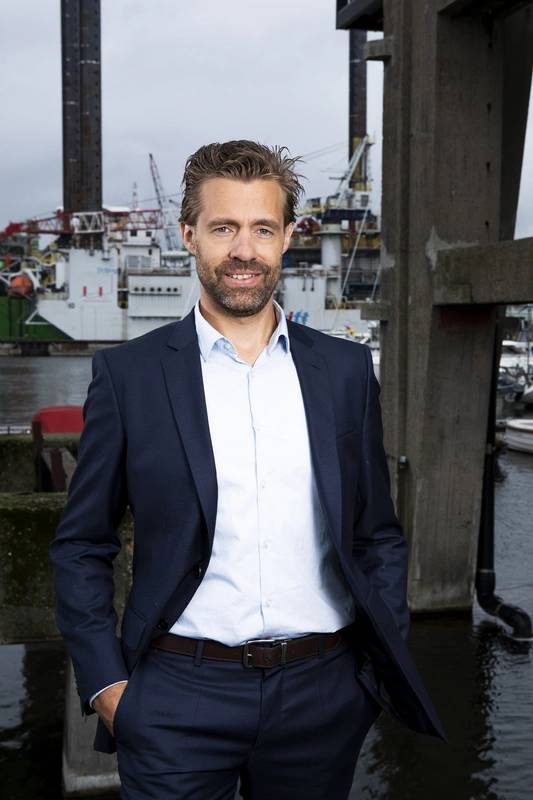 “This is a business which will be there forever because there's always something to be dredged. And today the fleet is rather old, so I think there are great opportunities,” said Basjan Faber, CEO of C-Job Naval Architects.
“This is a business which will be there forever because there's always something to be dredged. And today the fleet is rather old, so I think there are great opportunities,” said Basjan Faber, CEO of C-Job Naval Architects.
(Photo Courtesy C-Job Naval Architects)
Strong Technical Base
C-Job R&D knowledge and tools support the customizable TSHD series at every turn. The automation process supporting the C-Job TSHD series ensures any proposed changes can be quickly checked. The system will show how changes will alter the design and whether it is indeed feasible almost immediately. The company’s research into hydrogen-based renewable fuels offers another possible customization element to C-Job TSHD series for its customers.
It is in fact the power of the C-Job technical capability that enable the modularity and customization of the TSHD that differentiates it in the market. “C-Job is an independent company, so we are able to design the vessel to have it for a shipyard, easy to build,” Faber said. At the same time, it takes into account the requirements or the owner/operator regarding a vessel that is easy to maintain. “We have a special role; we are in the middle of this owner, shipyard and equipment suppliers, and it's up to us to adjust to the needs of all the parties involved.”
“We're going to use computer power to optimize the design,” Faber said. “Every time when we adjust something in the parameters of the vessel, we are going to use computer power with genetic algorithms to run through hundreds or even thousands of options to optimize the vessel for, for example, wave making resistance, steel weight. You can imagine what's important for design. So this is also something which is running on the background. So that's behind the screen, working for you to make the best design possible.”
“The great thing [about] having a platform like this, a design portfolio like this ourselves, is that it’s a way that we can combine all the innovations we are working on in our company,” Faber said. “This gives [us the] possibility to showcase all those innovations into the design platform.”
To that point C-Job is using data-driven analysis to research future fuels, including hydrogen-based renewables. It is looking into autonomous options. It places sustainability at the heart of every design, to not only improve the dredging operation to minimize turbidity, but to also design a platform not for today, and for tomorrow and the future requirements that might not yet be clearly defined.
“To create a platform—a design portfolio, as we now speak about; now we’re speaking about TSHDs, but there is more to come—these R&D elements are implemented throughout this design portfolio,” Faber said.
 (Photo courtesy C-Job Naval Architects)C-Job TSHD Series: 14,000 m3 Multifunction Dredger Features
(Photo courtesy C-Job Naval Architects)C-Job TSHD Series: 14,000 m3 Multifunction Dredger Features
- Twin gondola aft ship design
- Available and optimized for shallow water performance
- 14000-cu. m. V-shaped hopper
- 2 x 1200 mm trailing suction pipes, up to 30m dredging depth
- 2 x inboard dredge pump operating in both parallel (trailing) and in series (discharging)
- Option for extended trailing pipe with submerged pump up to 100 m dredging depth
- Pump ashore self-discharge system through;
Bow coupling and discharge pipeline
Rainbow system - 8 self-emptying bottom doors in one row
- 4 x closed diffusion boxes for reduced turbulence and maximum control of trim during operation
- Adjustable overflow system with anti-turbidity valve
- Draghead gantries with swell compensation system
- Jetwater system in hopper and on draghead






